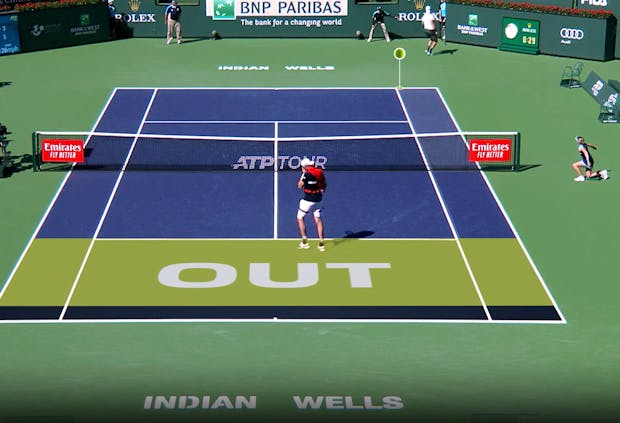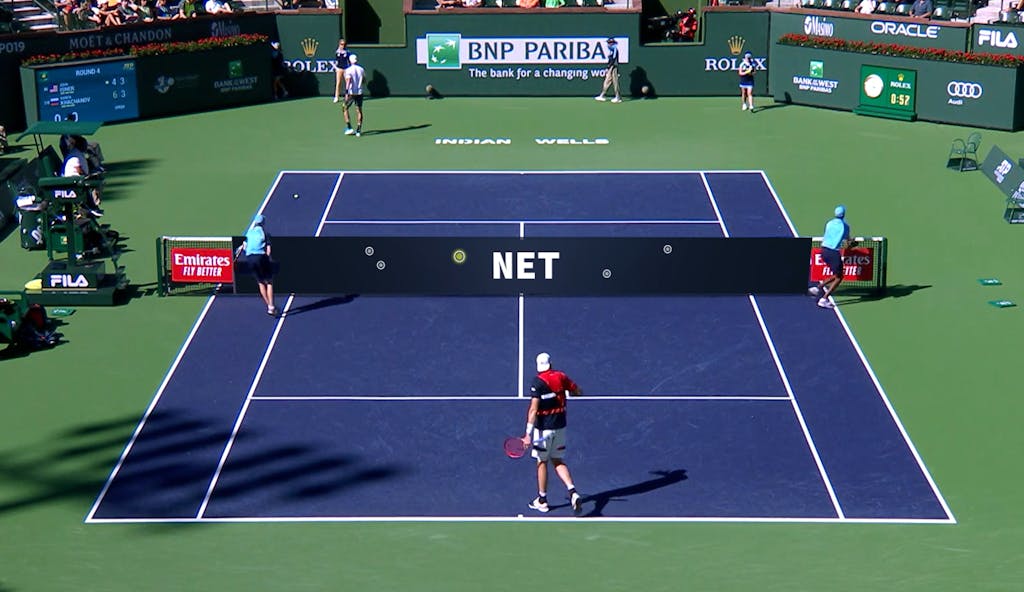
Sportradar’s six-year partnership with Tennis Data Innovations (TDI), a specialist joint venture vehicle of ATP and ATP Media, began in earnest at the start of the year – and the collaboration is already heralding transformational changes for fans of the sport.
Launched to coincide with the first ATP Masters 1000 tournament of 2024, from March 3-17 at Indian Wells in California, Sportradar 4Sight, the company’s AI-enriched streaming technology, is now available to sportsbooks that offer coverage of the men’s tennis tour.
According to Sportradar, the solution will truly transform the presentation of the sport.
In essence, the technology overlays ultra-fast data into live streams, delivering a continuous flow of engaging statistics that appear in real time, from serve speed and ball bounces, to total shots in each rally.
A dedicated on-site camera films the action, with ball movements captured as tracking data and converted through computer vision and AI into meaningful on-screen graphics. Whereas host broadcast feeds at tennis competitions typically cut away at the end of every point to focus on the reactions of the players or those watching in the stands, the Sportradar 4Sight feed remains fixed on the court itself, providing a platform for data-based visualisations and analysis.
Compelling solution

Sportradar’s senior vice president of audiovisual, Patrick Mostboeck, explains that the solution’s launch through a property as universally popular as men’s tennis is an ideal showcase for the company’s data, technology and media capabilities.
“It is a compelling solution that offers us the opportunity to engage the viewer and enhance their experience of the action with things they haven’t seen before,” he says. “This technology has matured over the past couple of years and fuelling it with data creates content that really resonates with the audience.”
Approximately 10 different types of overlays were available during Indian Wells, although Sportradar is constantly experimenting with new datatypes and metrics to explore what will grab the attention of viewers.
Whilst Sportradar 4Sight is currently only available through sportsbooks, there are plans to offer the solution through other platforms, with the data being contextually relevant for tennis enthusiasts as well as for bettors, who have a vast range of micro-betting markets at their fingertips.
“This solution allows us to introduce specific betting markets in appealing ways,” Mostboeck says. “Once we see that certain markets are of interest to sports betting customers, we can develop more visualisations around those markets.
“However, in addition, Sportradar 4Sight is engaging for the next generation of tennis fans who want more immersive and personalised experiences, and I think that’s where we all see the industry going.”

Table tennis test
From its vast audiovisual portfolio, which spans 500,000 live events and matches per year, Sportradar selected table tennis to begin testing Sportradar 4Sight in August last year ahead of launching with tennis this year.
“We selected table tennis deliberately as we were already collecting data automatically with our computer vision technology, and we could therefore feature a variety of datapoints,” Mostboeck adds. “It can be quite hard to follow the ball in table tennis as the players are so quick, but with Sportradar 4Sight, the rallies become more visible.
“We tested the technology in about 20 different venues and really learned a lot from that process. The main challenge with Sportradar 4Sight is to ensure you are displaying the right information in the context of the play. A viewer does not want to see a statistic pop up that is out of sync with the action.
“At the outset with table tennis, we prepared about 25 different overlays. However, we soon realised that the visuals were overwhelming, with graphics blinking all over the screen. So, we took a step back and asked ourselves: ‘What do we really need?’ Then we reduced the overlays by about half.”
Whilst further proof points for the technology will be expected to emerge in the pipeline of ATP events over the coming months and years, the table tennis integration has already provided tangible benefits.
“We saw specific micro-betting markets gain in popularity and there was an increase of between 10 and 15 per cent in terms of time spent consuming the action on betting platforms,” Mostboeck says.
Future innovations
Sportradar’s partnership with TDI features expanded in-play betting markets, short-form video highlights for registered users, and a range of personalised betting products, in addition to Sportradar 4Sight.
The collaboration covers all ATP Tour and ATP Challenger Tour events and, whilst launching Sportradar 4Sight for a major event like Indian Wells was always going to attract eyeballs, a tie-up with the ATP’s Challenger TV platform will offer Sportradar a useful avenue for trialling such streaming innovations in the future.
“As a business, TDI is very open to all sorts of ideas and both parties know that there will be elements of trial and error as we push each other to identify new innovations,” Mostboeck adds. “From a deployment perspective, testing things with coverage of the Challenger Tour would be relatively straightforward. With this technology, we can look beyond the core aspects of betting and streaming. It is possible to virtualise surfaces for sponsorship inventory and open new revenue streams, for example.”
The stable production environment with a fixed camera position coupled with the range of datapoints available through each rally ensure tennis is an ideal litmus test for the popularity of Sportradar 4Sight.
However, this is just the starting point for the technology’s application within sport. “It’s not a secret to say that, after tennis, football is very high up on our list, as well as basketball and other US sports,” says Mostboeck, who adds that Sportradar has earmarked Sportradar 4Sight integration with basketball in the second half of this year, with football also on the horizon.
“Football and basketball are very different from tennis as you have multiple players moving on the screen, so it is a bigger challenge to avoid, for instance, a graphic popping up and hiding another player. So, there are a lot of considerations.
“We will continue to work on Sportradar 4Sight and improve the solution, but I think this technology really sets a benchmark. We want to work with TDI to enhance the experience of viewers, and this is a good push in that direction.”